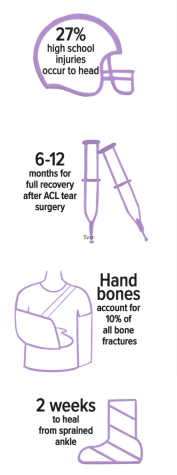Searching for the silver lining: Athletes persevere through injuries
An illustration depicting various injuries that commonly occur within sports including a concussion, a strained meniscus and an ankle sprain. “Injuries are part of the game,” varsity boys basketball coach Alfredo Alves said. “Every injury [is] different, but the longer you’re out, the longer you’re away from playing, so just mentally, [players are] adjusting and understanding that it’s going to take time.”
The past few months have brought some of the most eventful moments in sports, with audiences worldwide coming together under the universal interest for highly anticipated events such as the World Cup and National Football League (NFL) season. However, alongside the victories, a different kind of event has received an increase in attention — sports injuries.
Damar Hamlin, a safety for the New York Buffalo Bills NFL team, collapsed and underwent cardiac arrest after making a tackle on the field on Jan. 2. United States Men’s National Team (USMNT) star and Chelsea soccer player Christian Pulisic sustained a minor injury after he scored a goal for the U.S. during their match against Iran during the World Cup. San Francisco 49ers backup quarterback Jimmy Garoppolo broke his left foot, sidelining him for the remainder of the football season. Then, third string quarterback Brock Purdy tore his UCL in the NFC Championship game on Sunday. Even within high school athletics, many students struggle with sudden injuries that hinder their abilities to play their respective sports. And as many continue to watch these sports, people wonder about the hidden cost of playing a sport.
Varsity boys basketball head coach Alfredo Alves notes how injuries hugely impact athletes by not only forcing them into rehabilitation for a period of time, but also bringing uncertainty to their level once they recover and return to playing. He acknowledges the mental toll that some players take when they are away from their sport.
“Injuries are part of the game,” Alves said. “For the team, they have to adjust, but for the player, it’s a bit of a setback. Every injury [is] different, but the longer you’re out, the longer you’re away from playing, so just mentally, [players are] adjusting and understanding that it’s going to take time.”
Varsity girls water polo player Sofie Marino (10) suffered several injuries in her sport, including broken fingers and bruised bones, but her second concussion became the most severe injury that she experienced in her sport career. The concussion largely changed the way she viewed her sport as she was forced to watch from the sidelines for a year.
“I had to take a year off for the second concussion so that definitely impacted how I played because I wasn’t able to play at all for a really long time,” Sofie said. “And then when I got back, it took me a while to get back into the swing of things.”
Not being able to play for such a long amount of time proved difficult, especially because she had been playing the sport since the age of seven. Her long attachment to water polo brought mixed emotions as she watched her teammates compete.
“It was definitely hard to see other people play for the big tournaments and to see our team play without [me],” Sofie said. “It’s definitely hard to watch, and it also made me miss it at times, but it also made me kind of thankful to have time off to be able to focus on other things.”

Varsity girls basketball player Gemma Chan (10) also suffered injuries throughout her years of playing basketball, but a strained meniscus last fall prevented her from attending a month of pre-season workouts. She explains how her injury continued on and caused difficulties for her during tryouts.
“I was allowed to play, [but] during tryouts it started hurting, so I had to sit out and go to the trainers, which was hard because everyone else was trying out,” Gemma said. “So then I got scared that my spot would be taken because I wasn’t able to try out.”
Gemma touches upon the common desire amongst athletes to want to immediately return to their sport, but at the same time explained how demotivating the journey to coming back can be.
“I[t’s] been a little hard for me to process, because I obviously want to go back in, but you can’t because you have to get cleared and everything,” Gemma said. “It’s just this long process that you have to go through and it’s hard to find motivation to pursue that process.”
However, amongst the negative effects of an injury, there are several positive aspects, such as the potential to improve one’s physical abilities. Upper school head athletic trainer Wes Howard notes how one should stay active by training and strengthening other uninjured parts of the body.
“You have to be engaged and you have to do the work when you’re injured,” Howard said. “Let’s say [your] left shoulder [is] keeping [you] from being in games. Well, [you’ve] got two good legs and one good arm, so you’re going to workout every day. You have to stay in condition even though something else is bothering you.”
Howard notes how crucial staying active is while away from one’s sport in order to ensure a smooth transition back into practices and tournaments. In his years of experience, he describes recovering from an injury as a mindset that athletes have to work to maintain.
“You can work around the injury, so that when you do come back, it’s not like, ‘My legs are killing me, I’ve got no endurance, I can’t keep up,’” Howard said. “That’s the hard part of this level — the kids think they’re hurt so they shut down. So trying to change or bring in that mentality that there are no days off [is important].”

Emma Milner (12) is an Editor-in-Chief of Harker Aquila, and this is her fourth year on staff. This year, Emma wishes to experiment with new story formats...

Hima Thota (12) is a Managing editor for the Harker Aquila, and this is her fourth year on staff. Hima looks forward to capturing student and campus life...

Ananya Sriram (12) is a co-managing editor for the Winged Post, and this is her fourth year on staff. This year, Ananya hopes to bond more with members...

Katelyn Zhao (12) is the co-editor-in-chief of Humans of Harker, and this is her fourth year on staff. Katelyn aims to honor each of the stories within...


















![“[Building nerf blasters] became this outlet of creativity for me that hasn't been matched by anything else. The process [of] making a build complete to your desire is such a painstakingly difficult process, but I've had to learn from [the skills needed from] soldering to proper painting. There's so many different options for everything, if you think about it, it exists. The best part is [that] if it doesn't exist, you can build it yourself," Ishaan Parate said.](https://harkeraquila.com/wp-content/uploads/2022/08/DSC_8149-900x604.jpg)




![“When I came into high school, I was ready to be a follower. But DECA was a game changer for me. It helped me overcome my fear of public speaking, and it's played such a major role in who I've become today. To be able to successfully lead a chapter of 150 students, an officer team and be one of the upperclassmen I once really admired is something I'm [really] proud of,” Anvitha Tummala ('21) said.](https://harkeraquila.com/wp-content/uploads/2021/07/Screen-Shot-2021-07-25-at-9.50.05-AM-900x594.png)







![“I think getting up in the morning and having a sense of purpose [is exciting]. I think without a certain amount of drive, life is kind of obsolete and mundane, and I think having that every single day is what makes each day unique and kind of makes life exciting,” Neymika Jain (12) said.](https://harkeraquila.com/wp-content/uploads/2017/06/Screen-Shot-2017-06-03-at-4.54.16-PM.png)








![“My slogan is ‘slow feet, don’t eat, and I’m hungry.’ You need to run fast to get where you are–you aren't going to get those championships if you aren't fast,” Angel Cervantes (12) said. “I want to do well in school on my tests and in track and win championships for my team. I live by that, [and] I can do that anywhere: in the classroom or on the field.”](https://harkeraquila.com/wp-content/uploads/2018/06/DSC5146-900x601.jpg)
![“[Volleyball has] taught me how to fall correctly, and another thing it taught is that you don’t have to be the best at something to be good at it. If you just hit the ball in a smart way, then it still scores points and you’re good at it. You could be a background player and still make a much bigger impact on the team than you would think,” Anya Gert (’20) said.](https://harkeraquila.com/wp-content/uploads/2020/06/AnnaGert_JinTuan_HoHPhotoEdited-600x900.jpeg)

![“I'm not nearly there yet, but [my confidence has] definitely been getting better since I was pretty shy and timid coming into Harker my freshman year. I know that there's a lot of people that are really confident in what they do, and I really admire them. Everyone's so driven and that has really pushed me to kind of try to find my own place in high school and be more confident,” Alyssa Huang (’20) said.](https://harkeraquila.com/wp-content/uploads/2020/06/AlyssaHuang_EmilyChen_HoHPhoto-900x749.jpeg)




![An illustration depicting various injuries that commonly occur within sports including a concussion, a strained meniscus and an ankle sprain. “Injuries are part of the game,” varsity boys basketball coach Alfredo Alves said. “Every injury [is] different, but the longer you're out, the longer you're away from playing, so just mentally, [players are] adjusting and understanding that it's going to take time.”](https://harkeraquila.com/wp-content/uploads/2023/02/Sports_Injury-e1675462369361-589x900.png)